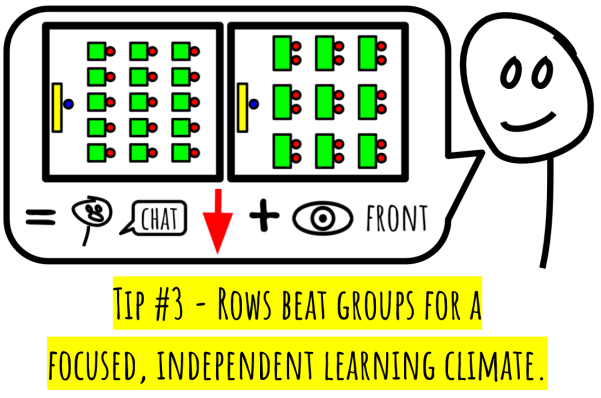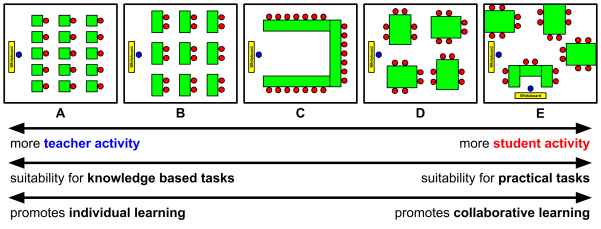 Reading time: 6 mins
Reading time: 6 mins
What does it look/sound like?
Arranging your tables in individual or paired rows will reduce distraction and promote concentration and independence.
Why you should use it?
Uh-oh, the headteacher’s office! As a pupil, I saw more of the head than the teachers: my mouthy antics habitually drew the attention of he-who-should-not-be-disturbed (it was always a he). The thought of the hairdryer treatment and the phone call home turned me green with nervous anticipation but
I don’t think this was a result of his reputation. It was more subtle than that: there were visual cues all around that said ‘you know who’s in charge here’. Chairs were lined up outside his room, floor-to-ceiling pot plants made my spine tingle, and his huge, oak desk was for more than just paperwork.
How your classroom layout talks to your pupils
Cues from the physical environment deeply influence how we behave. Have you ever found yourself whispering in a cathedral? Shouting at a football match? Our surrounding environments have long been known to encourage or inhibit certain behaviours. It’s the same in our classrooms and we can use this psychological trick to our advantage.
In one study (Wheldall, 1981), on task and off-task behaviours (defined by the quantity of ‘talk-outs’ and attention to the appropriate material amongst other indicators), was observed in a UK primary school classroom. The author found that on-task behaviour was more likely to occur in rows (88%) as opposed to groups (67% and 72%). Crudely put, this means that using rows reduced off-task behaviour by up to 21% and the evidence has been backed up by numerous other studies (Wheldall and Bradd; 2013).
Why though? Sommer (1977) describes how class layouts can convey the expectations and values of the class which in some ways is part of the ‘hidden curriculum’ – the unsaid values and lessons that pupils are expected to conform to and learn from. In the case of rows, facing the front implies looking at the teacher and focusing on what’s at the front of the class. Also, when pupils face in the same direction, there is less opportunity to engage with classmates. Therefore, this reduces the opportunity to distract and be distracted. Rows also allow easy movement of the teacher between tables which helps to bring you closer to your pupil’s work and helps you give support.
Is it rows vs groups or just horses for courses?

Because rows promote a calm, focused class climate, they are best suited to tasks which require high levels of concentration and independence such as writing or tests (Betoret and Artiga, 2014). Our curriculum is currently skewed towards the acquisition and application of knowledge so layouts which reduce distraction could pay huge dividends to your class.
However, just like everything in life, it’s important to note that no single layout is all-purpose. For more practical or collaborative learning, rows leave a lot to be desired. So, flexibility is necessary (I discussed this in a previous blog here). In future posts, I will explore how to build the routines that make flexibility a viable possibility and explain various strategies for collaborative learning.
However, for a focused, calm class climate, rows are the ideal primary arrangement of tables in your room.
References
Betoret, FD and Artiga, AG (2004). Trainee teachers’ conceptions of teaching and learning, classroom layout and exam design. Educational Studies. (30) 4.
Sommer, R (1977). Classroom Layout. Theory Into Practice. (16) 3, p174-175.
Wheldall. K and Bradd, L (2013) Classroom seating arrangements and classroom behaviour. Developments in Educational Psychology. 181-195.
Wheldall, K; Morris, M; Vaughan, P; Ng, Y (1981). Rows Versus Tables: an example of the use of behavioural ecology in two classes of eleven‐year‐old children. Educational Psychology. (30) 4, p171-184.

[…] Solution: use rows for focused, independent work. […]
LikeLike
[…] Grouped layouts are designed to encourage interaction. When the interactions aren’t focused on the learning, you’ve got a recipe for disruption. Numerous studies have shown that grouped layouts increase off-task behaviour significantly (Hastings & Schwieso, 1995; Wheldall & Lam, 1987; Yeomans, 1989). Wheldall et al (1981) found a 21% increase in ‘talking-out’ and not paying attention (among other indicators) when children were sat in groups compared to rows. The net effect is poor learning and increased teacher stress. (For more on the effects of table layouts, see my previous post.) […]
LikeLike